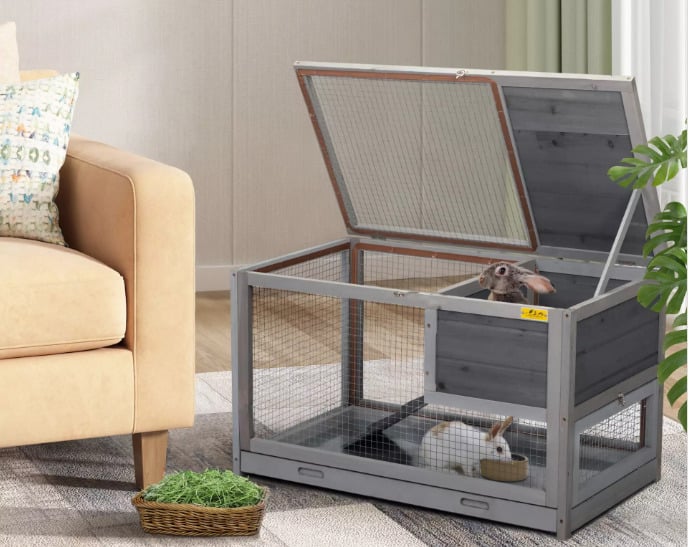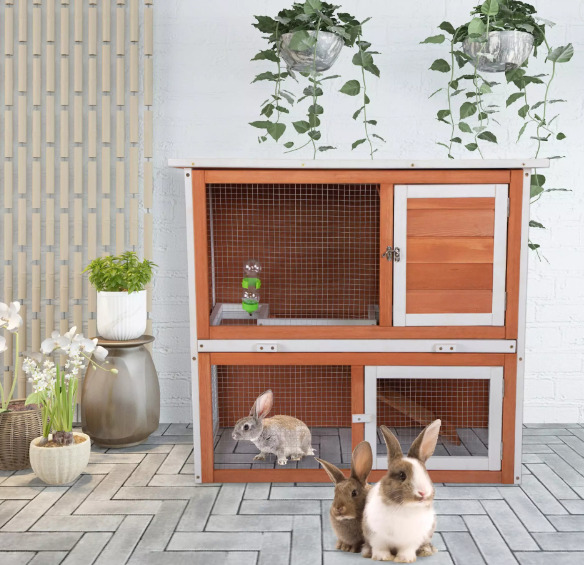As winter approaches, it’s essential to ensure that your furry companions are prepared to face the colder temperatures. If you have pet rabbits, their hutch requires special attention to keep them warm, safe, and comfortable throughout the chilly months. In this blog, we’ll explore practical steps to winterize your rabbit hutch, providing your adorable companions with a cozy haven that shields them from the harsh elements. Rabbits are sensitive to temperature changes, particularly extreme cold. Their hutch should be a sanctuary that shields them from low temperatures and harsh winds while maintaining proper ventilation.
Shelter and Insulation of Rabbit Hutch
Insulation and Weatherproofing: Start by insulating the rabbit hutch to create a barrier against the cold. Line the walls with insulating materials such as foam panels or heavy-duty blankets. Ensure that the insulation doesn’t obstruct the airflow; proper ventilation is crucial to prevent moisture buildup.
Windbreaks and Shade: Shield the rabbit hutch from strong winds by placing it against a wall, fence, or building. Positioning the hutch for rabbit away from prevailing winds helps create a more temperate microclimate for your rabbits. Additionally, provide shade during sunny winter days to prevent overheating.
Consider Indoor Housing: For particularly harsh winter conditions, you might contemplate bringing your rabbits indoors. A controlled indoor environment provides consistent warmth and eliminates exposure to extreme cold. If you choose this option, ensure that the indoor rabbit hutch is rabbit-safe and free from potential hazards.
Monitor Humidity Levels: Winter often brings dry air, which can affect the humidity levels in the rabbit hutch. Keep an eye on humidity levels and consider using a hygrometer to measure them. If the air becomes too dry, consider using a humidifier to maintain a comfortable environment for your rabbits.

Comfort and Hygiene of Rabbit Hutch
Add Extra Bedding: Increase the amount of bedding inside the rabbit hutch to provide additional insulation and warmth. Straw or hay works well for this purpose, offering both cushioning and heat retention properties.
Elevated Flooring: Raise the rabbit hutch off the ground to prevent direct contact with cold surfaces. This helps to minimize heat loss through conduction. A raised hutch for rabbit also keeps the interior drier by preventing water from seeping into the living area.
Enclosed Nesting Area: Create an enclosed nesting area within the hutch rabbit hutch where your rabbits can huddle together for warmth. Ensure this space is well-protected from drafts and insulated with extra bedding.
Regular Cleaning Routine: Maintain a consistent cleaning routine for the rabbit hutch during the winter months. Moist bedding can lead to mold and mildew growth, so ensure that damp or soiled bedding is promptly replaced. A clean and dry living space is essential for your rabbits’ health.
Protective Measures of Rabbit Hutch
Clear Ventilation Paths: While insulation is crucial, proper ventilation remains vital to prevent humidity buildup. Ensure that ventilation paths of rabbit hutch are clear and unobstructed to maintain air circulation and prevent condensation.
Heated Water Bottles: To prevent your rabbits’ water from freezing, use heated water bottles or bowls designed for outdoor rabbit hutch use. Ensure the bottles are properly secured to prevent spillage and potential hazards.
Cover Open Areas: If your rabbit hutch has wire mesh openings, cover them with plastic sheeting or burlap during winter. This helps block cold drafts while maintaining ventilation.
Reflective Heat: Place reflective heat blankets or panels on the sides of the rabbit hutch facing the sun. These materials help absorb and radiate heat into the hutch, providing additional warmth.

Enrichment and Observation of Rabbit Hutch
Outdoor Exercise Enclosure: While winter brings colder weather, rabbits still need regular exercise for their physical and mental well-being. Consider setting up an outdoor exercise enclosure near the rabbit hutch that provides protection from the wind and elements. This enclosed area allows your rabbits to stretch their legs, explore, and get fresh air without being exposed to the cold for extended periods.
Regular Health Checks: During winter, monitor your rabbits’ health closely. Ensure they are maintaining a healthy weight and show no signs of distress in the rabbit hutch, such as shivering or huddling excessively.
Heating Solutions: In extremely cold climates, you might consider providing additional heating options. Heat lamps or ceramic heat emitters can be placed in a safe and controlled manner to add warmth to the rabbit hutch. Make sure to position them in a way that prevents direct contact with the rabbits and minimizes fire hazards.
Provide Enrichment: Winter can lead to more time spent indoors, which might result in boredom for your rabbits. Keep them mentally stimulated by providing various toys and activities within the rabbit hutch. Puzzle feeders, chew toys, and tunnels can engage their minds and prevent them from becoming restless.
Monitor for Signs of Stress: Pay attention to your rabbits’ behavior and body language in the rabbit hutch. Signs of stress during winter can include decreased activity, changes in appetite, or huddling excessively. If you notice any concerning behaviors, consult a veterinarian for guidance.
Winterizing your rabbit hutch goes beyond mere preparation; it’s about creating a haven where your furry friends can thrive despite the colder temperatures. By insulating the hutch, elevating the flooring, and providing extra bedding, you’re offering them a comfortable space that protects them from the elements. With thoughtful planning and careful execution, you’re ensuring that your rabbits remain healthy, happy, and warm throughout the winter season. By going the extra mile to winterize their living space, you’re demonstrating your commitment to their well-being and enriching your special bond with your adorable companions.
https://www.vets-now.com/pet-care-advice/keep-rabbit-warm-winter/
